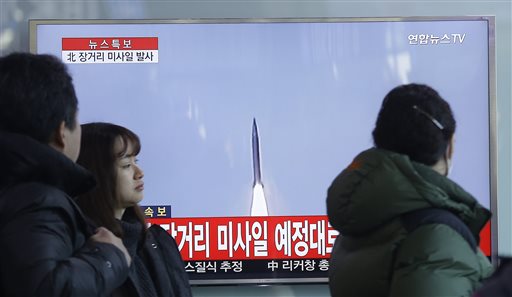What North Korea rocket launch may mean for region and world

South Koreans watch a TV news program with a file footage about North Korea’s rocket launch at Seoul Railway Station in Seoul, South Korea, Sunday, Feb. 7, 2016. North Korea on Sunday defied international warnings and launched a long-range rocket that the United Nations and others call a cover for a banned test of technology for a missile that could strike the U.S. mainland. AP Photo/Ahn Young-joon
SEOUL, South Korea — North Korea launched a long-range rocket Sunday, the first day of its announced eight-day launch window and about a month after the country’s fourth nuclear test led to international condemnation.
Already, world leaders are lining up to condemn the launch, which is being described as a potential threat to regional and world security.
For help on what it all means, some things to consider about the North’s latest move:
Satellite launch or missile test?
Article continues after this advertisementWashington, Seoul and others consider the launch a banned test of missile technology. That suspicion is based on the fact that Pyongyang has been openly pushing to manufacture nuclear-tipped missiles capable of striking the U.S. mainland and that the technology used to launch a satellite-carrying rocket into space can be applied to fire a long-range missile.
Article continues after this advertisementSimply speaking, a rocket is called a space launch vehicle when it is used to send up a satellite into orbit, but it becomes a missile when its payload is a warhead.
Getting a rocket into orbit takes less than 10 minutes. A missile would take about 30 minutes to travel from North Korea to the continental U.S., experts say.
What’s new about this launch?
After several repeated failures, North Korea successfully put a satellite into orbit aboard its three-stage Unha-3 rocket in December 2012. The North’s space agency said Sunday that it successfully put a new Earth observation satellite, the Kwangmyongsong 4, or Shining Star 4, into orbit less than 10 minutes after liftoff, and vowed more such launches. The United States and South Korea are still analyzing the launch.
South Korean defense officials say that a North Korean missile developed earlier than the Unha-3 rocket of 2012 has an estimated potential range of up to 10,000 kilometers (6,210 miles), which puts Hawaii and the northwest coast of the U.S. mainland within reach.
But critics say the North still has some technical barriers to surmount to achieve reliable nuclear weapons that can attack faraway targets. Among the important tasks facing North Korean scientists are thought to be building up a larger rocket that can fly farther and carry a heavier satellite or payload. This would be necessary if the North is going to develop a missile that can reach the entire U.S. mainland and be loaded with a warhead, which is several times heavier than the satellite the country launched in 2012.
The Unha-3 rocket from 2012 was about 30 meters (98 feet) tall and carried the Kwangmyongsong-3 satellite, which weighed about 100 kilograms (220 pounds). The sizes of the satellite and the rocket used in Sunday’s launch weren’t immediately known.
Outside analysts say the successful flight of a rocket loaded with a satellite weighing about 1 ton (2,200 pounds) would mean the North could probably develop a nuclear-armed long-range missile.
The North has been upgrading its Sohae launch pad since its 2012 launch. Satellite imagery showed the country completed an expansion of its launch tower there in late 2014 to accommodate larger rockets.
Consequences
It’s almost certain that the North will be slapped with fresh U.N. sanctions for the launch.
But critics are skeptical over whether any new sanctions can stop North Korea from continuing to pursue its nuclear and rocket programs because China, North’s last major ally and biggest aid benefactor and a veto-wielding power in the U.N. Security Council, is unwilling to cooperate on any harsh punishment on the North.
Beijing fears too much pressure on the North could cause it to collapse, pushing swarms of refugees over the countries’ border and establishing a unified Korea that hosts American troops on its doorstep.
The launch gives Kim, the North’s young leader, a chance to burnish his image domestically ahead of a landmark ruling Workers’ Party convention in May.
Because the North claims the launch as a success, it may think it has increased leverage in diplomatic negotiations and eventually propose talks with the United States and South Korea to try to win concessions, said Koh Yu-hwan, a professor at Seoul’s Dongguk University.